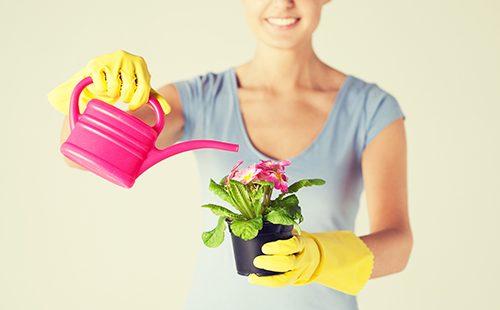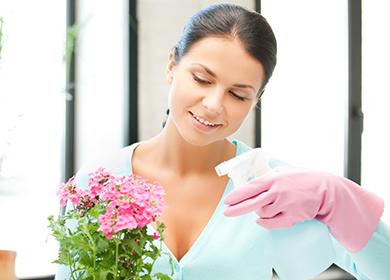The content of the article
Succinic acid is a natural compound. It is produced by living organisms and plants. In industry, it is obtained from amber and brown coal. In moderate amounts, it normalizes all processes occurring in plants, improves their growth, stimulates flowering.
Amber acid in floriculture: what is
Amber can be bought at a pharmacy. It is available in tablets, powder, in solutions for injection - in liquid form. The chemical name is butanedioic acid. The product is dissolved in water, the resulting solution is watered and flowers are sprayed. The benefits of succinic acid for plants are enormous. Dilute fertilizer and feed or water for example violets is not difficult, the main thing is to know the subtleties and rules of processing plants.
- Normalization of soil microflora. Succinic acid balances the activity of beneficial organisms, thereby restoring microflora.
- Toxins. Toxic substances accumulate in the substrate over time. Succinic acid destroys them.
- Growth stimulation. After the biological additive is added, nutrients from the soil are better absorbed by the root system. Flowers begin to grow faster.
- Adaptation Improvement. Accelerates the recovery of plants after illness, transplantation and other stressful situations. Helps newly purchased instances adapt faster to a new environment.
- Chlorophyll increase. If chlorophyll is produced in sufficient quantities, plants grow better, bloom, and look healthy.
- Acceleration of root formation. An indispensable tool for reproduction, transplantation, resuscitation of plants without roots.
- Increase resilience. Plants receiving small doses of succinic acid better tolerate drought, waterlogging, and frost.
Indications for use
The use of succinic acid for plants is necessary in different situations. The use of this substance helps indoor crops more easily survive stresses and recover from illnesses. The main indications for the use of succinic acid for plants are given in the table.
Table - When, for what and how to use succinic acid
| Indication | Task | Processing sequence | Dosage |
|---|---|---|---|
| Seed treatment before sowing | Increase germination | - Seeds are soaked for an hour in a solution; - then dried for half an hour in the shade | 0.2% solution (2 g per 1 liter of water) |
| Discard unobtainable seeds | - Soak the seeds in a low bowl; - as the evaporation is added to the solution (continue until biting); - hatching seeds are planted, the rest are thrown away | 0.05% solution (0.5 g per 1 liter of water) | |
| Cuttings | Stimulate root growth | - Pour the solution into a glass; - close the lid with a hole; - set the handle, keep in solution for up to 12 hours | 0.2% solution (2 g per 1 liter of water) |
| Planting cuttings and seedlings | Increase survival rate | Cuttings, seedlings are kept in solution for 1 hour | 0.25% solution (2.5 g per 1 liter of water) |
| Stress protection | - Accelerate adaptation in a new place; - help wake up after winter rest; - increase resistance to negative factors | Spray the plants from the spray at intervals of 2-3 weeks | 0.05% solution (tablet for 2-3 liters of water) |
| Restoration of oppressed plants | - Stimulate, enhance flowering; - return turgor to leaves; - accelerate growth | Spray with a solution at intervals of 2 weeks | 0.2% solution (2 g per 1 liter of water) |
| Recovery of diseased plants after transplantation | - Accelerate the formation of new roots; - restore the plant | Soak in solution for half an hour. | 0.1% solution (1 g per 1 liter of water) |
| Any transplant | - reduce stress; - accelerate growth | 0.05% solution (0.5 g per 1 liter of water) | |
| Getting kids, new shoots | Stimulate the growth of new shoots | In the spring, with the beginning of growth, watered with an acid solution | 0.2% solution (2 g per 1 liter of water) |
| Resuscitation of plants | Restore diseased, dying plants | - The whole plant is immersed in a solution for 10-15 minutes; - after 1-2 weeks spray | 2.5% solution (2.5 g per 1 liter of water) |
| Growth stimulation | Accelerate the growth of slow-growing crops | Watering and spraying alternate | 0.05% solution (0.5 g per 1 liter of water) |
These instructions for the use of succinic acid for plants will help you to navigate the dosage, achieve stable growth and flowering, increase resistance to diseases and negative external factors.
Preparation of solution for indoor flowers
In each case, a solution of a certain concentration is used. Usually, a base solution is prepared first, then it is brought to the desired dosage by adding water. Dilute succinic acid for watering plants is necessary according to the following scheme.
- Warm water. Pour to the bottom of a liter jar.
- Prepare a tool. Succinic acid is dissolved.
- Prepare a solution. Add water at room temperature to the top.
The concentration of the initial solution is 0.1%. For its preparation, 1 g of powder or ten 100 mg tablets are taken per liter of water. The concentration of the solution is reduced by adding water. For example, to make a 0.01% solution, 100 ml of stock solution and 900 ml of liquid are mixed.
Application features
The choice of method of use depends on the desired effect, the state of the plant. This can be feeding a healthy flower, relieving stress after a transplant or resuscitation. Among flower growers, the following methods of application are common.
Spraying
The most common use for healthy, weakened and diseased plants is spraying. The standard dosage for foliar top dressing is 0.01% solution. For plants in serious condition, it is increased. By spraying flowers with a biological additive, the following effect is achieved:
- pest protection;
- disease prevention;
- increased resistance to heat and cold;
- growth acceleration;
- formation of peduncles;
- long flowering;
- branching reinforcement.
Healthy plants are sprayed with a weakly concentrated solution every two to three weeks. For patients requiring resuscitation of specimens, the concentration is increased, the procedure is carried out daily, sometimes up to three to four times a day.
Soak
Soaking in solution is used for seeds, cuttings, plants with a damaged root system. Depending on the purpose, the concentration of the solution changes. By soaking, the following results are achieved:
- germination of stale seeds increases;
- seedlings grow strong;
- cuttings are actively building up the root system;
- bulbous plants quickly grow;
- bulbs do not become infected with fungal diseases;
- transplant stress is reduced;
- diseased plants recover faster.
According to the reviews of flower growers, when planting seeds and cuttings previously soaked in succinic acid, stronger plants are obtained. They are less likely to be attacked by pests, less likely to get sick, and withstand the effects of negative factors.

Watering
Florists recommend watering home plants with succinic acid for therapeutic and prophylactic purposes. It is recommended to use a more concentrated solution for this purpose. Even if the dosage is slightly exceeded, there will be no harm from succinic acid to indoor plants. A part of the bioadditive is absorbed by the plant, the excess is quickly processed by soil microorganisms. Periodic application of a biological additive gives the following results:
- soil microflora is restored;
- toxic substances and salts of heavy metals are excreted;
- fungal diseases are prevented;
- damaged root system is restored.
Orchid treatment
Naughty tropical flowers react vividly to the introduction of succinic acid. The tool heals the substrate, promotes the active flow of photosynthesis, stimulates the formation of peduncles. This is an indispensable “medicine” for weakened or dying orchids. The whole plant is sprayed with a solution, avoiding contact with the flowers. When transplanting, the roots are soaked in it to minimize stress.
For frequent processing of orchids, a weak solution is used - 1 g of crystalline powder is added to 5 l of liquid. Sprayed every three weeks, the residues of the finished product watered the soil. With the systematic introduction of supplements, orchids are less likely to get sick and stably bloom.
In the work, succinic acid is most convenient for indoor plants in tablets. Each tablet contains 100 mg (0.1 g) of acid, which simplifies the preparation of a small amount of solution. But no matter in what form of release you managed to purchase the drug, it will greatly benefit indoor flowers.
Reviews: "The benefits are colossal"
I have been using it for several years. Especially often for indoor plants. But also on the flower beds. The pot works well. There plants in cramped conditions, more often problems arise, and succinic acid helps a lot.
Irina, http://cveti-sad.ru/yantarnaya-kislota-dlya-rastenij-i-dlya-pochvy-xorosha/
I use succinic acid before planting indoor plants in permanent soil (in pots): 1 gr. acid dilute 1 liter. water, a more concentrated solution. With this solution, water the earth in pots (plentifully) and let them stand for 3 days. Then we plant plants there. We obtain plants that are resistant to disease and transplantation, and even metabolism and growth of even the damaged root system, resulting in healthy plants, increase. I have been using this method for about 5 years, no problems, the benefit is enormous.
Alexey, http://sazhaem.info/care/manure/yantarnaya-kislota-dlya-komnatnyh-rastenij.html

